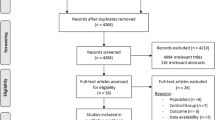Abstract
The objectives of this paper are to: quickly outline the extent of the care gap in osteoporosis; define T-2 (knowledge) translation and its relationship to quality improvement; discuss the barriers to best practice in osteoporosis care after a fracture; convey the importance of rigor in design and evaluation of translational interventions by drawing upon examples from the broader literature; describe in some detail a series of post-fracture intervention trials conducted in Alberta, Canada; and make some conclusions specifically about osteoporosis interventions and more generally about T-2 translational research.

Similar content being viewed by others
References
Eliot-Gibson V, Bogoch ER, Jamal SA, Beaton DE (2004) Practice patterns in the diagnosis and treatment of osteoporosis after fragility fracture: a systematic review. Osteoporos Int 15:767–778
Giangregorio L, Papaioannou A, Cranney A et al (2006) Fragility fractures and the osteoporosis care gap: an international phenomenon. Semin Arthritis Rheum 35:293–305
Curtis JR, Adachi JD, Saag KG (2009) Bridging the osteoporosis quality chasm. J Bone Min Res 24:3–7
McGlynn EA, Asch SM, Adams J et al (2003) The quality of health care delivered to adults in the United States. N Engl J Med 348:2635–2645
Adams AS, Soumerai SB, Lomas J, Ross-Degnan D (1999) Evidence of self-report bias in assessing adherence to guidelines. Int J Qual Healthc 22:187–192
Majumdar SR, McAlister FA, Furberg CD (2004) From knowledge to practice in chronic cardiovascular disease: a long and winding road. J Am Coll Cardiol 43:1738–1742
Woolf SH (2008) The meaning of translational research and why it matters. JAMA 299:211–213
Auerbach AD, Landefield CS, Shojania KG (2007) The tension between needing to improve care and knowing how to do it. N Engl J Med 357:608–611
Hayward RA, Asch SM, Hogan MM et al (2005) Sins of omission: getting to little medical care may be the greatest threat to patient safety. J Gen Intern Med 20:686–691
Eccles M, McColl E, Steen N et al (2002) Effect of computerized evidence based guidelines on management of asthma and angina in adults in primary care: cluster randomized controlled trial. BMJ 325:941–948
Majumdar SR, Soumerai SB (2009) The unhealthy state of health policy research. Health Aff Millwood 28:900–908
Black AD, Car J, Pagliari C et al (2011) The impact of e-health on the quality and safety of healthcare: a systematic overview. PLoS Med 8:1–16
Yarnall KS, Pollak KI, Ostbye T et al (2003) Primary care: is there enough time for prevention? Am J Publ Health 93:635–641
Majumdar SR, Tsuyuki RT, McAlister FA (2007) Impact of opinion leader-endorsed evidence summaries on the quality of prescribing for patients with cardiovascular disease: a randomized controlled trial. Am Heart J 153:22–29
Rogers EM (1995) Diffusion of innovations, 4th edn. The Free Press, New York, pp 290–311
Majumdar SR, Rowe BH, Folk D et al (2004) A controlled trial to increase detection and treatment of osteoporosis in older patients with a wrist fracture. Ann Intern Med 141:366–373
Majumdar SR, Johnson JA, McAlister FA et al (2008) Multifaceted intervention to improve osteoporosis diagnosis and treatment in patients with recent wrist fracture: a randomized controlled trial. CMAJ 178:569–575
Majumdar SR, Johnson JA, Bellerose D et al (2011) Nurse case-manager vs multifaceted intervention to improve quality of osteoporosis care after wrist fracture: randomized controlled pilot study. Osteoporos Int 22:223–230
Majumdar SR, Lier DA, Rowe BH et al (2011) Cost-effectiveness of a multifaceted intervention to improve quality of osteoporosis care after wrist fracture. Osteoporos Int 22:1799–1808
Majumdar SR, Beaupre LA, Harley CH et al (2007) Use of a case-manager to improve osteoporosis treatment after hip fracture: results of a randomized controlled trial. Arch Intern Med 167:2110–2115
Morrish DW, Beaupre LA, Bell NR et al (2009) Facilitated bone mineral density testing versus hospital-based case management to improve osteoporosis treatment for hip fracture patients: additional results from a randomized trial. Arthritis Rheum 61:209–215
Majumdar SR, Lier DA, Beaupre LA et al (2009) Osteoporosis case-manager for patients with hip fractures: results of a cost-effectiveness analysis conducted alongside a randomized trial. Arch Intern Med 169:25–31
Rucker D, Rowe BH, Johnson JA et al (2006) Educational intervention to reduce falls and fear of falling in patients after fragility fracture: results of a controlled pilot study. Prev Med 42:316–319
Bogoch ER, Elliot-Gibson V, Beaton DE et al (2006) Effective initiation of osteoporosis diagnosis and treatment for patients with fragility fracture in an orthopaedic environment. J Bone Joint Surg 88-A:25–34
Dell R, Greene D, Schelkun SR, Williams K (2008) Osteoporosis disease management: the role of the orthopaedic surgeon. J Bone Joint Surg 90(suppl 4):188–194
Sacks H, Chalmers TC, Smith H (1982) Randomized versus historical controls for clinical trials. Am J Med 72:233–240
Little EA, Eccles MP (2010) A systematic review of the effectiveness of interventions to improve post-fracture investigation and management of patients at risk of osteoporosis. Implement Sci 5:80–88
Shojania KG, Ranji SR, McDonald KM et al (2006) Effects of quality improvement strategies for type 2 diabetes on glycemic control. A meta-regression analysis. JAMA 296:427–440
Peikes D, Chen A, Schore J et al (2009) Effects of care coordination on hospitalization, quality of care and healthcare expenditures among Medicare beneficiaries: 15 randomized trials. JAMA 301:603–618
Ayanian JZ (2009) The elusive quest for quality and cost savings in the Medicare Program. JAMA 301:668–670, Piekes
Acknowledgments
The author was supported by a Health Scholar salary award from the Alberta Heritage Foundation for Medical Research and Alberta Innovates-Health Solutions.
Conflicts of interest
None.
Author information
Authors and Affiliations
Corresponding author
Rights and permissions
About this article
Cite this article
Majumdar, S.R. A T-2 translational research perspective on interventions to improve post-fracture osteoporosis care. Osteoporos Int 22 (Suppl 3), 471 (2011). https://doi.org/10.1007/s00198-011-1700-4
Received:
Accepted:
Published:
DOI: https://doi.org/10.1007/s00198-011-1700-4




